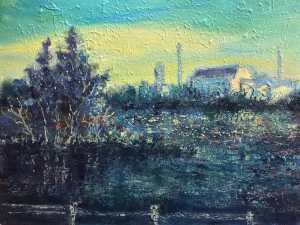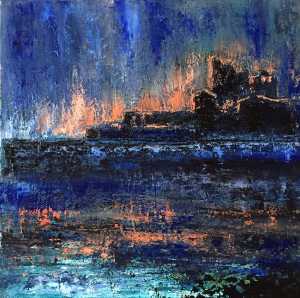Natalya Onidi
Deutschland
Natalya Onidi.com
Kunstart: Malerei
Technik: Ölmalerei
Stil: Expressionismus
Vita / Lebenslauf:
In 2010 Natalya began a series of private classes at various London institutes, and compiled a new body of work. This London acquired portfolio helped her secure a place on the University of Chester's Fine Art and Painting degree course, from which she graduated with honors in 2016.
Working almost exclusively in Oils, she has had several exhibitions in UK.
After graduation Natalya relocated to Luxembourg and more recently to the city of Berlin, where she has embarked upon a career as a professional artist and has had solo exhibition.
Natalya is a member of the professional artist union of Berlin.
The personal artistic practice investigates the theme of urban landscape and urban decay: searching for structure, space, colour relationships, surface tensions and diverse marks in an attempt to explore an emotional response to the subject and to reveal the subject matter's spirituality. There follows an exploration of several compositional ideas in an attempt to analyse how best to place various elements to their maximum advantage; e.g. by balancing the geometrical forms of the buildings and by paying close attention to tonal value in order to give depth. The same collection of buildings are to be examined from different viewpoints and at different times of the day in order to ascertain their dimensions and rhythms. Thus controlled light and shade will become key elements of the work.
Additionally, experimentation with the surface of water and reflection of inverted lines have been implemented as outlined by Peter Doig who observed that; 'the mirroring opened up another world. It went from being something like a recognisable reality to something more magical.'
Throughout this practice, photographs, drawings and studies act as an initial starting point, facilitating both a position of observational detachment; allowing for separation between subject and reflection, and facilitating experimentation with media, scale, and process. From this perspective the series of paintings created, lead ultimately to a definitive statement. Consideration has been given to the advancement of, and change in, the quality of the imagery. Moving away from realistic detail towards a more expressive and imaginative representation; accordingly, 'all sense of depth and surface, distance and proximity, materiality and illusion can be lost.' (P. Doig )
Various media has been used throughout this practice, including: oil paint, acrylics, wax tempera, and oil bars; these substrates have been combined with fine sand and mixture of natural turpentine and linseed oil. Experiments with imprimature have been undertaken, i.e. variations of thin or thick layers in different hues, onto canvas, and the paint has been treated in different ways: e.g. scratching, scrapping, jabbing, pushing or dragging it over the surface. In his book 'What Painting is,' Elkins describes this art form as a co-action between the artist's desire and the irregular disposition of the media; a mixture of 'rational control and intuitive freedom.'
|
|
|
















